England
Crossing the border from Scotland to England is rather anti-climatic, there is a small sign, some English flags, and a truck selling Fish and Chips. If we didn't slow down, we would have missed it.
As we are making our way towards our first stop in England we spot a majestic looking castle and stop to check it out. Turns out it's just a centerpiece for a Holiday RV park, Only the tower of Haggerston Castle remains. What was once a proud castle tied to William the Conqueror, dating back to 1311, is now just a landmark and a storeroom for motorhome travelers. Just a photo stop.
Not just a photo stop is the impressive Bamburgh Castle, proudly overlooking the ocean. The castle has been maintained and restored in excellent condition, and a beautiful sandy beach lays below it. Sadly the weather was changing from sun to rain so we couldn't enjoy the beach.
Bamburgh Castle dates back to 420 AD, until the vikings destroyed it in 993, and then the Normans rebuilt it. There is a large archeological excavation being conducted on the grounds as they keep discovering ancient artifacts and history. We ate lunch in the classic tea rooms and wandered the grounds and buildings of the castle where the movie 'Elizabeth' was filmed.
One odd thing about this castle was the freaky bugs all over anything yellow, a yellow Ford Mustang was completely covered in these small black bugs, yellow backpacks and bags were covered by crawling insects, and some even were attracted to my Khaki pants, time to leave.
We ran into some really bad traffic through Newcastle, and pushed on to our destination for the night, the historic town of Durham, home to an 11th century Cathedral and Castle.
 Almost every town in Europe has a Tourist information center, they are invaluable, free town maps, sightseeing highlights, and most importantly room booking services. For a few pounds they can find you a place in your price range and convenient to touring the town.
Almost every town in Europe has a Tourist information center, they are invaluable, free town maps, sightseeing highlights, and most importantly room booking services. For a few pounds they can find you a place in your price range and convenient to touring the town.
Durham
After a bunch of hunting, we finally found the tourist information center. The girl there was extremely helpful, being late in the day, she looked for places near to the town, and asked if we thought of staying at one of the colleges. Apparently while the students are away for the summer, they rent out their dorm rooms to tourists. We ended up with a room at the historic Hatfield College, the largest room of the trip, it included breakfast, parking, was a block from the Cathedral, and ended up being one of our cheapest accommodations of the trip, score!!!
Durham Cathedral and Castle are nestled on a hilltop overlooking the town and the River Wear, since it was less than a block from our cozy room, we headed to the Cathedral in hopes of catching the evensong performance. It's a nightly church choir that is supposed to be an amazing experience, it's normally nightly, but not in the summer. As we explored the cathedral we could hear a choir singing, and found them behind closed doors in an off-limits area. We listened through the windows to an amazing collection of voices as it echoed through the courtyard.
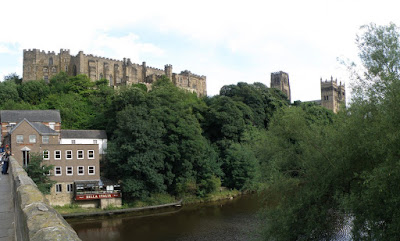
From the Cathedral we walked across the lawn to the Norman Castle built in 1066, it may have been impressive from the outside, but we would never know about the inside as it was closed due to a wedding reception. We should have figured there was something going on seeing people in suits and an assortment of fancy dresses, tourists just don't dress that well.
From the hilltop location we wandered down into the town of Durham. It's always interesting to see the historic pubs of old towns like 'The Shakespeare' and 'The Fighting Cocks'.
There's always something funny to be found in the shopfronts of historic squares.
After wandering the historic town we stopped for a wonderful riverside meal at Café Rosa, before returning to our dorm room, and listening to the Cathedral bells as we drifted to sleep.
After a Hogwarts style cafeteria breakfast at the college, we packed up and headed North towards the famous Hadrian's Wall. The 80 mile long Hadrian's wall was started in 122 AD by the Roman Empire, the stone structure was built across the narrowest part of Great Britain to protect against attacks by the Scottish tribes. It was also said that Hadrian didn't want his armies to be sitting around doing nothing, as "a bored army results in bad things", so keeping them busy was key.
The area that we stopped at was known as Housesteads, and it served as a great vantage point to not only see the wall, but also explore an ancient Roman fort that was part of the fortifications.
After seeing enough of rock walls it was time to get back to nature and head to the Lake District, a rural area in Northwest england famous for its lakes and mountains. This area is probably the most popular holiday destination for Englanders not wanting to leave the country during the summer, we pass one camping trailer after another as we make our way into the Lake District.
The Lake District
The first town in the northern lake area is Keswick, a 13th century small town on Derwent Water lake. First stop is the TI center to find a room. With the popularity of the Lake District it would be a challenge, there was nothing available in town, so we booked at a farm house outside of town for 1 night, and another B&B at the southern end of the lake area for the next night.
Knowing we had somewhere to stay, we walked from town to the very popular Derwent Water lake, a typical resort style lake area, complete with tourist shops, Ice cream stands and boat rentals.
It seems strange to be all the way over here and see a lake full of Canada Geese, who knew?
After wandering the touristy area, we jumped in the car and headed to our Greenbank country house B&B. The classic farmhouse feels like Switzerland, it sits on the slop of a hill, and our window looks out onto a scenic hillside area. As soon as we arrive we are offered tea and some cakes/cookies, as we must be exhausted... too bad we weren't staying here 2 nights.
Greenbank Country House B&B
Now that we were re-energized with a cup of tea and cakes, we decided to head to the nearby Buttermere Lake and do the 4.5 mile hike that circles around "the lake by the dairy pastures".
We find a "Pay and Display" parking area which is very common in England, and head down the path to Buttermere lake. You cross through some farmers fields, by permission, but not without some "friendly" warnings. It's a beautiful area, with classic farms and curious locals.

After seeing the crowds at Derwent Water, we are pleasantly surprised to find we are by ourselves almost the entire hike around the lake. It's a relatively easy hike, with amazing views.

Turns out, it's also one of the nicest afternoons of our trip, the clouds have cleared out, and sunny blue skies shine down on us and our hiking companions... sheep are everywhere!
Feeling all powerful after our big hike, we decide to get some spiritual energy and go in search of the Castlerigg Stone Circle. It took us 3 passes to find the small road that leads to it, we saw lots of countryside in either direction, and magically came upon the field unlabelled on the side of a farm road. Amazing to see a structure dating back to 3200 BC, and it just sits in a farmers field, free to anyone to enjoy it. Arriving late in the day there is a few other people picnicking and waiting for the sun to set on this mystical place set in the middle of the Cumbrian mountains.
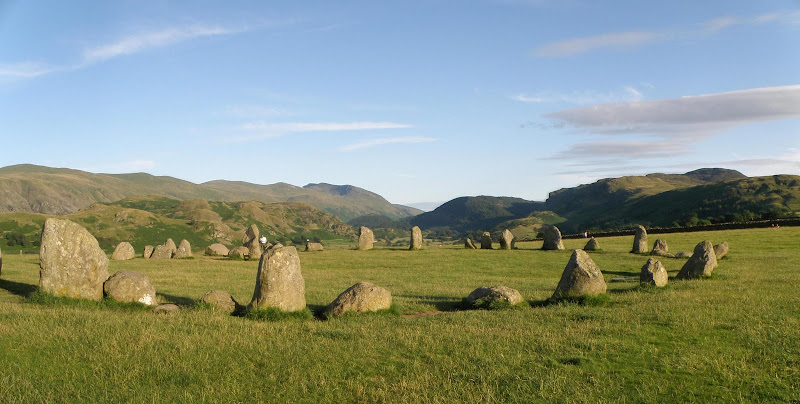
We debated the history and meaning of this site... Was it Druids? Was it part of some other ritual? Was it just a meeting place for axe trading? How did they get 16 Ton rocks here? How did they align the stones to match up to key dates and solar systems? Why 40 Stones?
Leaving the Stone Circle in awe, we headed to Keswick for dinner, and back to our farm house.
Did I mention it was too bad that the room was only available for 1 night?
After a full English breakfast, (exactly the same as the Full Scottish Breakfast), it's time to head out in the pouring rain, to the South Lake District and search out the infamous Peter Rabbit.
As we are heading south we decide to turn off to a town called Grassmere and somehow end up on narrow/steep winding road, it's an interesting roller coaster past forest and country houses, and it's too narrow to turn around. We enjoyed the experience, but in an Outer Limits way it caused us to travel past "Dove Cottage" Wordsworth's home, without knowing it, until it was too late, oops.
Our first stop was the Village of Hawkshead, a cute little town that is home to the Beatrix Potter Gallery. It's a collection of Beatrix Potter artwork, and the office of her husband. If you don't know who Beatrix Potter is, she was the turn of the century author and artist of the Peter Rabbit stories.
A little further south at other end of Windermere lake, is the Beatrix Potter Hilltop farm, her 17th century home where she was inspired and created many of the famous characters of her children's tales. Peter Rabbit, Jemimah Puddle-duck, and Squirrel Nutkin are still popular with kids over 100 years later. Our Nephew still has his Peter Rabbit stuffed bunny from when he was born.
As we arrive at her farm, almost on cue, a rabbit pops out of the shrubs, it has to be Peter Rabbit, or one of his descendants! The farm is a collection of fenced sheep areas, English gardens, and a still functioning barn. We toured her tiny house, then had lunch at a local pub, where we watched a family playing an intense game of knots and crosses... known in Canada as Tic-Tac-Toe.
Windermere is the largest natural lake in England, and has been a holiday destination since the 1800's. From Hilltop Farm, we have to take a small car ferry to get to the other side of Windermere, and arrive smack-dab in the middle airshow traffic. It's a zoo, there is no parking, there's barely room to drive, as millions of people get settled in for a view of the planes.
After a long slow crawl we eventually get out of the area and make our way up the narrow windy roads to the town of Ambleside. We check into the Anchorage B&B, which is nice and clean, but has the worlds smallest bedroom. a narrow trail around the bed leads to a camper style bathroom. You know, the bathroom where the shower head, toilet and sink are all in the same closet... yeah.
After checking in, it's a short wander into town, the town definitely has an updated resort town feel, but there is some unique elements such as the Bridge House, which is over 300 years old, and was used as a combination summer house and apple store. Now it's an info center.
The gothic St. Mary's Church brings a gothic feel to the town. Built in 1854, it still feels old for such a new church, and is very different from all the other St. Mary's Churches we would see.
From town it's only a 1 mile walk to the north end of Windermere lake. Lucky for us the rain stopped as we started walking, unlucky for us the wind came, and it was blowing hard.
We find a nice park bench to sit and enjoy the view over the lake. We must have looked like a couple seagulls hogging the bench, because a British couple came by and tells us "The Red Arrows aren't until 5:15"... I tell her I don't know what that is, and she starts laughing, telling her husband, "They don't know what the Red Arrows are". He tells us they are a British Military flying group, like those American Blue Angels. Norine and I mutter to ourselves, "you don't know who the Canadian Snowbirds are, Beeaatch!". As enthralled as we are to see the amazing flying walendas of Britain, we decide not to wait around for an hour and walked back through town, and then watched the Red Arrows do their maneuvers from the comfort of the bed, out our B&B window.
After enjoying the air show, we head back into Ambleside and find a great little Cantonese restaurant for dinner. At the end of the meal we get fortune cookies and a free swiss army knife.
The next morning it's time to leave the Lake District, and start heading South. It's a 2.5 hour drive to the impressive Castle Howard and it's grounds. Technically not really a castle, this stately home has been a prominent building in the history of the Earls and Kings of England over the last 300 years, and still is. It was also the setting for the TV series and movie 'Brideshead Revisited'.
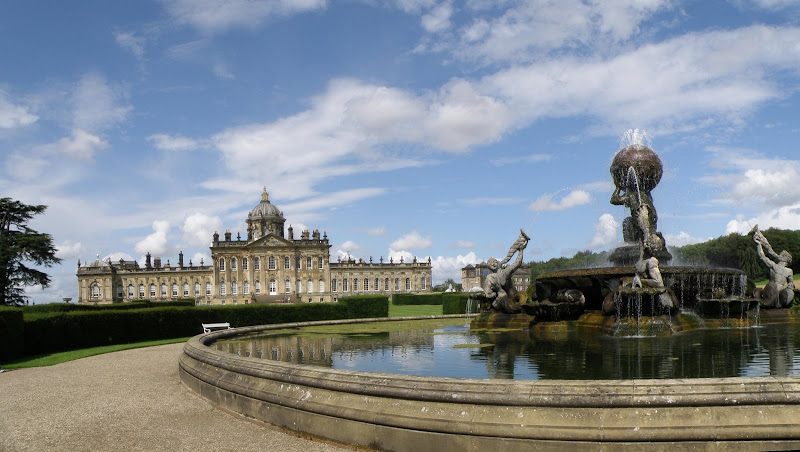
The inside of the castle is even more impressive than the outside, unlike a lot of the defensive castles we have seen, this one is a functioning home and has a palace feel to it.
Back on the grounds of Castle Howard, we head to the Temple of the 4 Winds, and are given another free airshow, 2 jets are buzzing the grounds, and blasting past with full afterburners.
York
After Castle Howard, we needed to go somewhere that was equally as impressive, next stop, the historic walled city of York. First stop, the TI center, where the girl got a great deal for us. She negotiated us a 160£ room for 95£, plus she got them to throw in breakfast and parking. Not only that, but the hotel is right across the street from the York Minster... sweeeeeeet!
Our great little hotel
York was founded by the Romans in 71 AD, its history includes being taken over by the vikings in 866 AD, and then the Normans in the 13th century. It was a very strategic city, located on the Rivers Ouse and Foss, exactly half way between the capitals of London and Edinburgh.
York Minster, the second largest Gothic cathedral in northern Europe, stands at the city's centre.
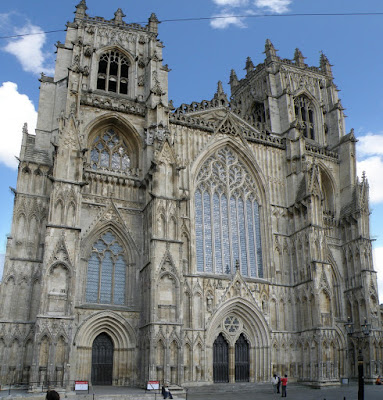
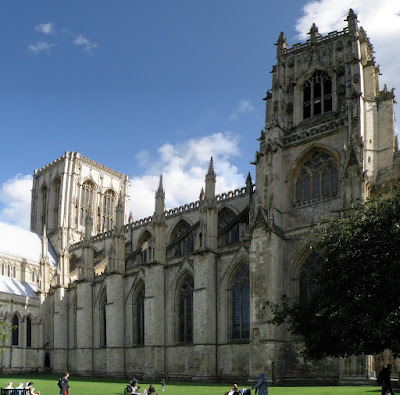
It's history dates back prior to the 10th Century, the different architecture of the altars and different areas of the Minster give a sense of how it has evolved over the centuries.

After exploring the York Minster, and discovering they wouldn't have Evensong either, we worked our way towards the walls past some great historic buildings, one tudor, one mansion.
The medieval walls of the city are one of its very unique features, and it's a very nice 3 mile walk around the city, with great views and opportunities for finding other landmarks.
From the walls we get a great perspective over the York Minster, and unique looks into history.
The Ice House which looks like a brick igloo was used to store ice that was either collected in the winter or purchased from northerly cities. Don't ask me to try 'Bile Beans', but apparently they date back to 1899, and were supposed to keep you healthy, slim and attractive.
Time to come down off the walls for a while, so we wander into the area known as The Shambles. Back in the 14th century these shops were all butcher shops displaying their meat on hooks in front. Today the narrow street with leaning buildings still has some of the hooks, but has become a shopping area, you may have seen it portrayed as Diagon Alley in the Harry Potter movies. We arrived after 6 o'clock and it's a ghost town... maybe that will be in Harry Potter too?
Dwarfed in the shadows of York Minster are several smaller but unique churches such as St. Marys (yes, another church called St. Mary's... weird huh?) with it's excellent collection of gargoyles.
York Castle, and Clifford's Tower, had a long history of rebuilt wooden castles from 1068, until in 1244, when the Scots threatened to invade England, King Henry III visited the castle and ordered it rebuilt in stone, at a cost of about £2,500. The work commenced in 1245, and took almost 25 years to complete. Clifford's Tower is an unusual design, shaped like a four leaf clover.
We checked out a few more unique structures and headed back up onto the walls.
Back at ground level, the river walk shows that bridges don't have to be boring. If you have old gate houses going unused, why not make them useful, make them into sandwich shops?
Having covered most of the city, the next stop is the ancient ruins of the St. Leonard Hospital and St. Mary's Abbey. The hospital was the largest hospital in England during the middle ages. The Abbey was a key figure in English history, dating back to 1055 AD, and appeared prominently in the early medieval ballads of Robin Hood. The destruction of both complexes was demanded by King Henry VIII when he created the church of England in defiance of the Roman Catholic Church.
After a full day of walking, it's time to forage for food. When we see the Georgian style Mansion House built in 1725, we just have to turn our heads to find Harkers old town pub, a great destination for a pint and some dinner. Another very good meal in the land we were warned that the food was no good, I don't think we have had a bad meal yet.
After dinner we head back to our room, where they lent us a wireless laptop to use in the room for free. Did I mention how great this hotel was? That and they have a full size shower.
Today would be a day of a lot of driving as we worked our way from York down to the Cotswolds region. Along the way we would find places of interest to stop and break up the day.
The first stop would be the infamous Nottingham of Robin Hood fame... The real reason to stop is for a bathroom break, but crazily this town appears to have no bathrooms. I guess Robin Hood just went in the forest. We hunted through town, even made 2 gas station stops, one doesn't have a WC, the other is closed for repairs. To our relief we finally find a bathroom, by that time we have had about enough of Nottingham and the Sherwood Forest, back to the highway.
It's a little intimidating as you drive along and see 2 huge nuclear reactors on the side of the road. The first with 6 stacks, the next one had 8, we quickly drive past on our way to Warwick Castle.
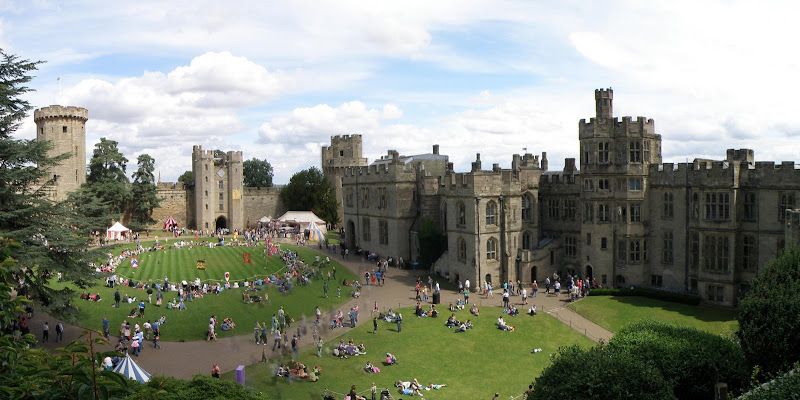
Warwick Castle was built by William the Conqueror in 1068. In 1978 it was purchased by a company and is now the Disneyland of castles. A steep fee to get in, big crowds, and a combination of Madame Tusaud meets theme park makes this beautiful castle feel wrong.
It's 530 steps up and around the walls/towers to reach its highest point, but the climb is well worth it, for the view over the town and the River Avon. From the top of the towers, we head inside to check out the royal apartments, the grand hall and even the gaol (jail) before leaving.
I should say attempting to leave. When we came in the parking lots are full and we end up parked a mile away in a big farm field. That didn't stop them from wanting another 3£ for parking, we didn't think we needed to, and ended up trapped at a tollgate without a token. After the security guy scolded us, and I scolded them for charging us after paying so much to get in, then parking so far away, we paid for the token, and let the line of cars behind us follow us through the gate.
From the overly commercial castle of Warwick we headed to the very important historical town of Stratford-upon-Avon. It's hard to measure the importance of the town where William Shakespeare was born. It seems that importance has gone to the head of the woman working at the Tourist Information center. When we ask her to help us book a place in another town, she becomes very unhelpful. "I can't help you at 4pm, it's busy season you know". So unlike every single other TI we leave this one without having a room booked for the night.
Shakespeares house is a restored 16th century half-timbered house where William Shakespeare was born in 1564 and spent his childhood years. Today it is set up as a museum to show what it was like during those years, when his father was a glove maker and wool dealer.
The Cotswolds
It's a short drive to the Cotswold Hills area, a region of England consisting of scenic hillsides and quaint little villages. The name Cotswold apparently means "sheep enclosure in rolling hillsides".
The Cotswolds were designated an Area of Outstanding Natural Beauty in 1966, equivalent to the same landscape quality and status as a National Park.
The first town we visit is called Chipping Campden, and we're very nervous about where we will stay tonight after the hoity-toity lady in Stratford-upon-Avon's TI giving us her scare tactics. Strangely after stopping at the 1st hotel that looks nice, we have a great room at the Lygon Arms. Hmmm, apparently it may be busy season, but there still is rooms available... great rooms.
Chipping Campden would be our base for a few days to explore the Cotswolds, the drizzle must have scared off the tourists, as we wandered our home base, it seemed like a ghost town. 'Chipping' comes from an Olde English term meaning market or market-place, and the 1627 Market Hall with its arches is the centerpiece of this historic village.
There is a lot of interesting little nooks and crannies here, including the Campden House and its elaborate gateway. There's the don't blink or you'll miss it archway to Wilson Memorial Gardens. Of course no town is complete without a St Mary's Church, and Chipping Campden is no different.
Before heading for dinner, and since it had stopped raining, we wanted to walk into the residential area of Campden and find some of the thatched roof houses. As we are walking past nice old homes we pass a cat on the way, and make the mistake of petting it. From that point on the cat followed us everywhere we went. We wind our way through neighborhoods, and the damn cat kept following us. At one point we are walking past a stone and shrub fence, and suddenly 2 dogs burst their heads out to get a good look at the cat. You'd think that would scare the cat, cause it scared the %&$# out of us... but no, the cat just put us between him and the dogs.
That damn cat is even in my pictures
When we finally get to the too-cute-to-be-true thatch roof houses, the cat is still with us. We can't just lead him into another neighborhood, so we HAVE to go back the way we came instead of doing a planned loop. When we get back to where we first saw him, he goes to scratch in the garden, and we go running around the corner like crazy people so he doesn't follow us, stupid cat.
Back in town we have a yummy Fish and Chip Dinner at a quaint hotel, before calling it a day.


